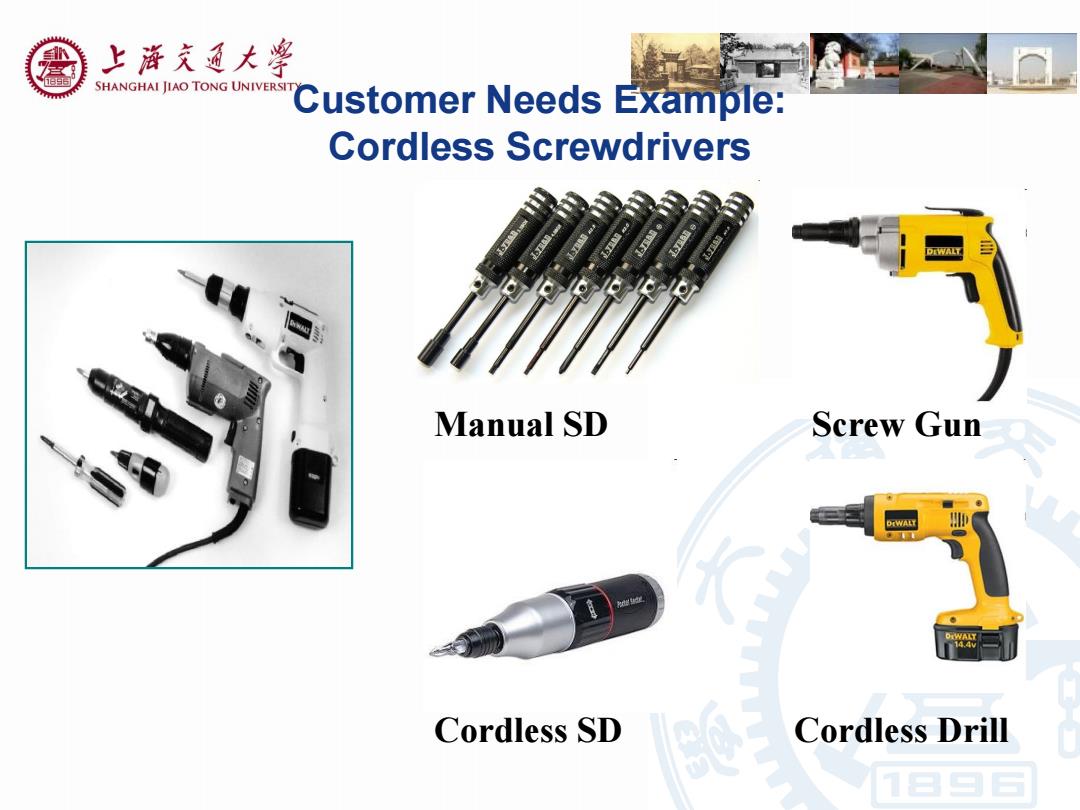
上游充通大学 SHANGHAI JIAO TONG UNIVERSITY Chapter 4 ldentifying Customer Needs 1月回后
Chapter 4 Identifying Customer Needs

上游充通大粤 SHANGHAI JIAO TONG UNIVERSITY Product Design and Development Karl T.Ulrich and Steven D.Eppinger 5th edition,Irwin McGraw-Hill,2012. Chapter Table of Contents: 1.Introduction 2.Development Processes and Organizations 3.Product Planning 4.Identifying Customer Needs 5.Product Specifications 6.Concept Generation 7.Concept Selection 8.Concept Testing 9.Product Architecture FIFTH EDITION 10.Industrial Design Product Design 11.Design for Environment and Development 12.Design for Manufacturing 13.Prototyping 14.Robust Design 15.Patents and Intellectual Property 16.Product Development Economics 17.Managing Projects KARL T.ULRICH STEVEN D.EPPINGER
Product Design and Development Karl T. Ulrich and Steven D. Eppinger 5th edition, Irwin McGraw-Hill, 2012. Chapter Table of Contents: 1.Introduction 2.Development Processes and Organizations 3.Product Planning 4.Identifying Customer Needs 5.Product Specifications 6.Concept Generation 7.Concept Selection 8.Concept Testing 9.Product Architecture 10.Industrial Design 11.Design for Environment 12.Design for Manufacturing 13.Prototyping 14.Robust Design 15.Patents and Intellectual Property 16.Product Development Economics 17.Managing Projects

上游充通大¥ SHANGHAI JIAO TONG UNIVERSITY Concept Development Process Concept Planning Detall Teeting and Development Deeign Deelgn Refinement Ramp-Up 4980m Concept System Spec Critical Design Producton Review Approval ★”门 Mission Develppment Statement Identify Establish Generate Select Test Set Plan Pan Customer Target Product Product Product Final Downstream Needs Specifications Concepts Concept(s) Concept(s) Specifications Development Perform Economic Analysis Benchmark Competitive Products Build and Test Models and Prototypes
Concept Development Process

上游充通大粤 SHANGHAI JIAO TONG UNIVERSITY Satisfying needs is just as important in revolutionary products as in incremental products A
Satisfying needs is just as important in revolutionary products as in incremental products

上游充通大 SHANGHAI JIAO TONG UNIVERSITY Customer Needs Process Define the Scope Mission Statement Gather Raw Data Interviews Focus Groups >Observation Interpret Raw Data Need Statements Organize the Needs >Hierarchy Establish Importance Surveys Quantified Needs Reflect on the Process Continuous Improvement
Customer Needs Process Define the Scope Mission Statement Gather Raw Data Interviews Focus Groups Observation Interpret Raw Data Need Statements Organize the Needs Hierarchy Establish Importance Surveys Quantified Needs Reflect on the Process Continuous Improvement

上游充通大¥ SHANGHAI JIAO TONG UNIVERSIT Customer Needs Example: Cordless Screwdrivers Manual SD Screw Gun 4.4v Cordless SD Cordless Drill
Customer Needs Example: Cordless Screwdrivers Manual SD Cordless SD Screw Gun Cordless Drill

上浒充通大¥ SHANGHAI JIAO TONG UNIVERSITY Mission Statement Example:Screwdriver Project Product Description A hand-held,power-assisted device for installing threaded fasteners 多 Key Business Goals >Product introduced in 4th Q of 2000 >50%gross margin >10%share of cordless screwdriver market by 2004 Primary Market >Do-it-yourself consumer Secondary Markets >Casual consumer Light-duty professional Assumptions Hand-held >Power assisted Nickel-metal-hydride rechargeable battery technology Stakeholders >User Retailer >Sales force 7 Service center > Production Legal department
Mission Statement Example: Screwdriver Project Product Description A hand-held, power-assisted device for installing threaded fasteners Key Business Goals Product introduced in 4th Q of 2000 50% gross margin 10% share of cordless screwdriver market by 2004 Primary Market Do-it-yourself consumer Secondary Markets Casual consumer Light-duty professional Assumptions Hand-held Power assisted Nickel-metal-hydride rechargeable battery technology Stakeholders User Retailer Sales force Service center Production Legal department

7三 上游充通大学 SHANGHAI JIAO TONG UNIVERSITY Step 1:Gather Raw Data from Customers ●●● Relevant Research Tools Primary Secondary Scanning Qualitative Quantitative Listening to ·Customer Visits ·Survey Research the“voice ·Focus Groups Choice Modeling of Naturalistic Observation Experimentation products" Exploring Confirming Understanding Measuring ●Sebastian Fixs0n Product Design and Development Babson/RISD
Step 1: Gather Raw Data from Customers

上游充通大粤 e SHANGHAI JIAO TONG UNIVERSITY How? Interview One to one interview in the customer's environment Typically last one to two hours Focus groups A moderator facilitates a two-hour discussion with a group of 8 to 12 customers In a special room allowing several members of the development team to observe The moderator is a professional market researcher,but a team member sometimes moderates The proceedings are usually videotaped $50 to $100 paid for the participants(customers) Total cost of a focus group is about $5000 Rental of the room Participant fees Videotaping Refreshments
How? Interview • One to one interview in the customer’s environment • Typically last one to two hours Focus groups • A moderator facilitates a two-hour discussion with a group of 8 to 12 customers – In a special room allowing several members of the development team to observe – The moderator is a professional market researcher, but a team member sometimes moderates – The proceedings are usually videotaped – $50 to $100 paid for the participants (customers) • Total cost of a focus group is about $5000 – Rental of the room – Participant fees – Videotaping – Refreshments

上游充通大¥ SHANGHAI JIAO TONG UNIVERSITY How many customer? 100 80 60 40 20 0 5 10 15 20 25 30 Number of consumers interviewed From:Griffin,Abbie and John R.Hauser."The Voice of the Customer", Marketing Science.vol.12,no.1,Winter 1993
How many customer ?